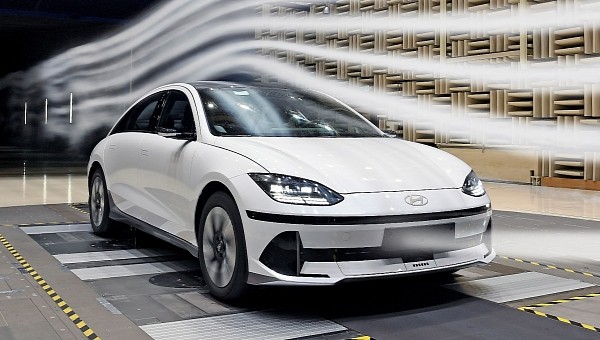The Mercedes-Benz EQS is the most aerodynamic series-production vehicle, priding itself on a 0.20 drag coefficient. The Hyundai Ioniq 6 isn’t too far behind, sporting a 0.21 drag coefficient.
How did the South Korean automaker manage to design such a slippery vehicle? Inspired by the Stout Scarab, Phantom Corsair, and Saab Ursaab, the Ioniq 6 “started with a single curve that defines its profile and architecture.” Hyundai Motor Company head of styling Simon Loasby further claims that “the true beginning of aerodynamic design and engineering started in the 1930s,” the era that gave us the Chrysler Airflow, the first full-size American production car to boast streamlining.
Influences were also taken from the aeronautical industry, with Hyundai’s aerodynamic development team taking inspiration from the Supermarine Spitfire. The winglets to the side of the rear spoiler are designed to absorb the air flow from the roof, reducing drag by minimizing vortices at the spoiler’s lip. Said technology also reduces eddy currents generated by the air traveling on the sides of the sedan-bodied sibling of the Ioniq 5 SUV.
Hyundai also took note from nature, according to head of aerodynamics Jinhyuck Chang. He gives the peregrine falcon as an example, a bird that reaches 390 kilometers per hour (242 miles per hour) diving for its prey.
Another piece of aerodynamic trickery that enables the Ioniq 6 to travel up to 614 WLTP-rated kilometers (382 miles) in one go is the active air flap integrated into the front bumper. Wheel air curtains, wheel gap reducers, separation traps, and wheel deflectors also need to be mentioned, along with an undercover that blocks the front lower area to improve air flow. The final piece of the puzzle is the aero diffuser under the rear bumper.
“Through their collective efforts, Hyundai’s aerodynamic engineers and designers have achieved with Ioniq 6 a new benchmark for Hyundai and the Ioniq dedicated EV lineup brand,” said Min Byung-hoon, the executive vice prez and director of vehicle performance development.
Influences were also taken from the aeronautical industry, with Hyundai’s aerodynamic development team taking inspiration from the Supermarine Spitfire. The winglets to the side of the rear spoiler are designed to absorb the air flow from the roof, reducing drag by minimizing vortices at the spoiler’s lip. Said technology also reduces eddy currents generated by the air traveling on the sides of the sedan-bodied sibling of the Ioniq 5 SUV.
Hyundai also took note from nature, according to head of aerodynamics Jinhyuck Chang. He gives the peregrine falcon as an example, a bird that reaches 390 kilometers per hour (242 miles per hour) diving for its prey.
Another piece of aerodynamic trickery that enables the Ioniq 6 to travel up to 614 WLTP-rated kilometers (382 miles) in one go is the active air flap integrated into the front bumper. Wheel air curtains, wheel gap reducers, separation traps, and wheel deflectors also need to be mentioned, along with an undercover that blocks the front lower area to improve air flow. The final piece of the puzzle is the aero diffuser under the rear bumper.
“Through their collective efforts, Hyundai’s aerodynamic engineers and designers have achieved with Ioniq 6 a new benchmark for Hyundai and the Ioniq dedicated EV lineup brand,” said Min Byung-hoon, the executive vice prez and director of vehicle performance development.












